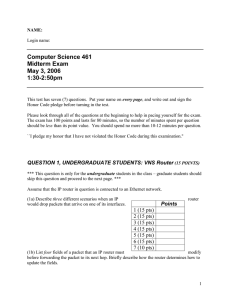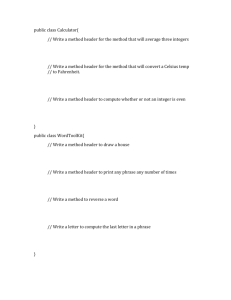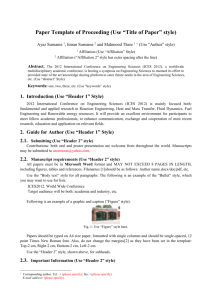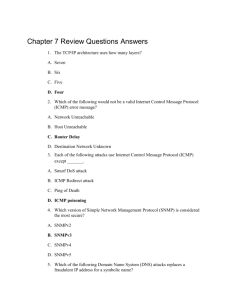version with answers
advertisement
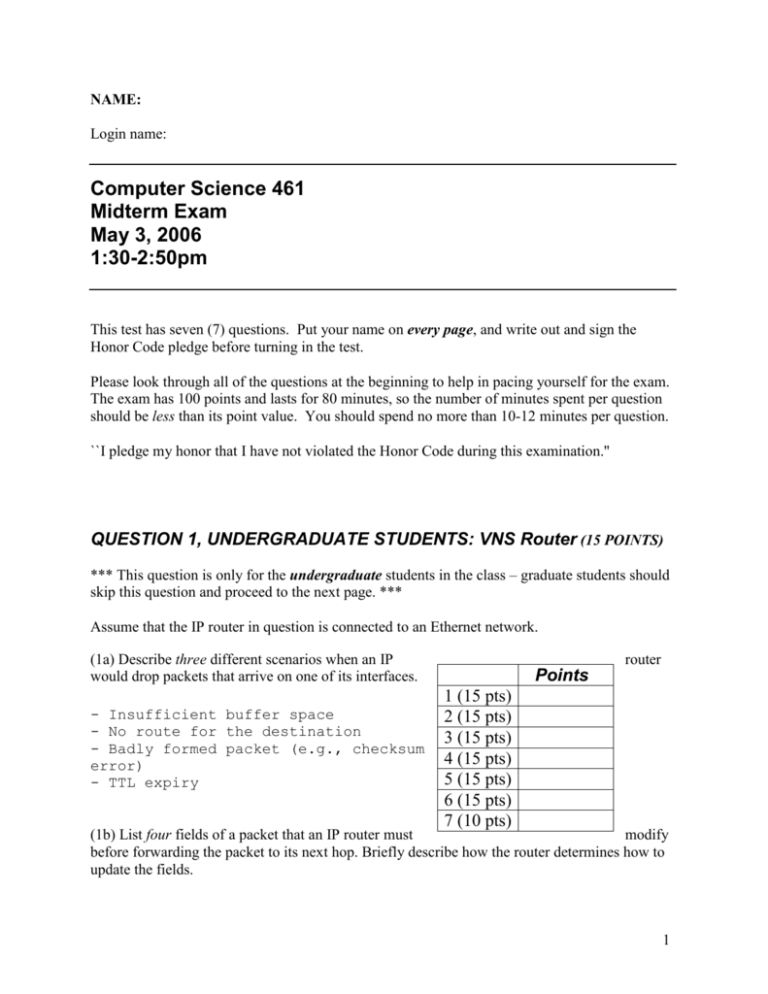
NAME: Login name: Computer Science 461 Midterm Exam May 3, 2006 1:30-2:50pm This test has seven (7) questions. Put your name on every page, and write out and sign the Honor Code pledge before turning in the test. Please look through all of the questions at the beginning to help in pacing yourself for the exam. The exam has 100 points and lasts for 80 minutes, so the number of minutes spent per question should be less than its point value. You should spend no more than 10-12 minutes per question. ``I pledge my honor that I have not violated the Honor Code during this examination.'' QUESTION 1, UNDERGRADUATE STUDENTS: VNS Router (15 POINTS) *** This question is only for the undergraduate students in the class – graduate students should skip this question and proceed to the next page. *** Assume that the IP router in question is connected to an Ethernet network. (1a) Describe three different scenarios when an IP would drop packets that arrive on one of its interfaces. - Insufficient buffer space - No route for the destination - Badly formed packet (e.g., checksum error) - TTL expiry router Points 1 (15 pts) 2 (15 pts) 3 (15 pts) 4 (15 pts) 5 (15 pts) 6 (15 pts) 7 (10 pts) (1b) List four fields of a packet that an IP router must modify before forwarding the packet to its next hop. Briefly describe how the router determines how to update the fields. 1 - Source MAC address Destination MAC address IP time-to-live field IP header checksum (1c) What state does an IP router maintain about its directly-connected neighbors? How does the router maintain this state? - ARP cache (table of neighboring Eth/IP mappings) - ARP protocol (periodic refresh and in response to ARP requests) 2 QUESTION 1, GRADUATE STUDENTS: Quality of Service (15 POINTS) *** This question is only for the graduate students in the class – undergraduate students should skip this question and proceed to the next page. *** (1a) Consider an ATM network with a leaky-bucket policer (also known as a token-bucket filter) that ensures a virtual circuit does not send more cells than expected. If the policer has a bucket depth of 10 cells and a token rate of 100 cells/second, how many cells can the virtual circuit transmit during a one-second period? In a ten-second period? Burst of 10 cells plus the token rate. So, 110 for one second. And 1010 for ten seconds. (1b) Suppose a link has a propagation delay of P seconds and transmits R cells per second. Suppose a cell arrives when the link has Q other cells awaiting transmission, and has just started transmitting the first cell. What delay does the new cell experience, as a function of P, R, and Q? Propagation delay of P seconds With Q other packets in the queue, must wait for Q+1 transmissions at one every 1/R seconds. So, the total delay is P + (Q+1)/R (1c) Suppose a link has a first-in-first-out queue and carries traffic for two virtual circuits. The traffic on the first virtual circuit obeys a token-bucket filter with a bucket depth of 9 cells and a token rate of 100 cells/second, and can settle for best-effort service. The traffic on the second virtual circuit obeys a token-bucket filter with a bucket depth of one cell and a token rate of 100 cells/second, and cannot tolerate more than 100 msec of delay in delivering each cell. Suppose the propagation delay on the link is 60 msec. What is the smallest transmission rate R, in cells per second, that can satisfy the delay constraint, given that the link serves cells in first-in-firstout order? If the link rate is less than the sum of the two token-bucket rates, then an arbitrarily long backlog can develop. Otherwise, the link can drain the queue as fast as cells arrive, except for a burst of cells that arrive at the same time. This burst size is limited by the sum of the two bucket depths, allowing a backlog of at most 10 (i.e., 9 + 1) cells. If the one cell from the delay-sensitive virtual circuit arrives just after the other nine, it experiences delay P + 10/R, where P is 60 msec. For the total to be less than or equal to 100 msec, we must have 10/R less than or equal to 40 msec. Thus, R must be at least 250 cells/second. 3 (1d) Explain why a different kind of link scheduler would allow a smaller value of R to suffice. Forcing both virtual circuits to share the same queue makes the delay-sensitive virtual subject vulnerable to bursty traffic from the other virtual circuit. Having separate queues, with strict priority or weighted fair scheduling, would limit the impact the burst virtual circuit would have on the performance experienced by the cells in the delay-sensitive virtual circuit. 4 QUESTION 2: Intradomain Routing (15 POINTS) (2a) The picture below shows a network with 8 routers, where each link has an integer weight (e.g., the link between u and v has weight 2). Add arrowheads to the picture to illustrate the shortest-path tree rooted at u. For example, the edge from u to v would be marked with an arrow head where the line meets node v. Please draw neatly. 2 u 2 w 2 v 1 2 4 1 4 2 3 All but three nodes are reached along the clockwise path starting at node u, with costs of 2, 4, 5, and 7, respectively. The other three nodes, down and to the right of u, are reached with costs of 2, 3, and 6, respectively, through u’s downward neighbor. (2b) Suppose node u sends a large amount of traffic to node v, consuming most of the bandwidth on the (u,v) link. The traffic from u to w also traverses the (u,v) link. To alleviate congestion on the (u,v) edge, the network administrator plans to change the weight of the (v,w) edge to divert the traffic from u to w onto another path. What is the minimum weight the (v,w) edge would need to force all of the traffic from u to w to take a different path? What is the maximum weight the link could have while still ensuring the traffic from v to w goes directly over the (v,w) link? The next shortest path from u to w goes down from node u and has a cost of 5 (= 2 + 1 + 2). To make the path (u,v,w) strictly longer, it needs to have a length of 6 (i.e., 2 + 4). So, the answer is 4. If the cost of edge (v,w) is too large, even traffic from v to w would choose a different path. The next shortest path from v to w goes through u and has a cost of 7 (= 2 + 2 + 1 + 2). So, the cost of the (v,w) edge should not exceed 6. 5 (2c) Why would a network administrator change the link weight, rather than simply relying on the end hosts (connected to node u) to adapt their sending rates in the presence of congestion? Although TCP senders slow down in the presence of congestion, this does not ensure that network resources are used efficiently. Two TCP senders might each send at half the rate of a shared link while another path lies idle. By changing the link weights, the network operators can change the paths the traffic traverses – something TCP cannot do – allowing the TCP senders to transmit at higher rates and offer better performance to users.QUESTION 3: Interdomain Routing (15 POINTS) (3a) How does the Border Gateway Protocol (BGP) avoid the count-to-infinity problem that plagues distance-vector protocols? BGF is a path-vector protocol. That is, BGP announcements include the entire path traversed by the message, not simply a total cost. A router, upon receiving a BGP announcement, can check for its own AS number in the path; if the AS number is present, the path has a loop and is immediately discarded. (3b) A tier-1 Internet Service Provider (ISP) is an Autonomous System (AS) that offers transit service to its customers but has no upstream providers of its own. The small collection of tier-1 ISPs (e.g., UUNET, Sprint, AT&T, and Level3) all connect directly to each other, with peer-peer relationships. Why does a tier-1 ISP need a peer-peer relationship with every other tier-1 ISPs? Having no upstream providers of its own, a tier-1 ISP must rely on its peers and customers to reach remote destinations. However, the ISP can only reach its own customers (and its customers’ customers, recursively) through the connections to customers. A tier-1 ISP must peer with another tier-1 ISP so they can reach each other’s respective customers. The peering is “full mesh” because a peer does not provide transit service, meaning that two ISPs cannot communicate through a mutual peer. 6 (3c) Give two examples of filtering policies applied to BGP sessions, one for an import policy (filtering routes sent by a neighbor) and another for an export policy (filtering routes sent to a neighbor). - Import filtering: discarding prefixes that a customer advertises but does not own - Export filtering: not announcing peer-learned routes to another peer QUESTION 4: World Wide Web (15 POINTS) (4a) An HTTP response message can include a “Last Modified” time, indicating the last time the requested object was modified. When a user requests an object that resides in the browsercache, the browser generates an HTTP request message with an “If Modified Since” header to ask the server to return a fresh copy only if the object has been modified since the previous request. How is it possible for the “If Modified Since” cache-validation technique to work, even if the two machines have vastly different notions of time (i.e., no clock synchronization)? Both timestamps are from the viewpoint of the server, making the client’s notion of time irrelevant. That is, the server transmits the “Last Modified” time, and the client returns this timestamp as the argument of “If-Modified-Since” in a subsequent request. (4b) To make an HTTP request, the client establishes a TCP connection and sends an HTTP request message. An HTTP request message has a “Host” header than includes the name of the server (e.g., “Host: www.cnn.com”). Why is the Host necessary? Wouldn’t the server already know its own name? A single server might host multiple Web sites, making the Host header necessary to distinguish between the sites. The Host header is also important when the client connects to a server through a proxy, so the proxy knows which site to contact. (4c) A Content Distribution Network (CDN) replicates the same content in many locations throughout the world. A CDN typically directs clients to the appropriate replica by returning customized answers to DNS queries (e.g., by controlling the response to a request for the IP address of www.cnn.com). Give two reasons why a CDN would return different IP addresses in response to the same DNS query, from different clients? - load balancing - directing client to nearby replica - customized content based on geographic location 7 (4d) When using DNS to direct clients to Web server replicas, a CDN typically sets the DNS Time-to-Live (TTL) to a small value. Why? Provide two negative implications of having a small TTL value. - why: to retain control over replica selection, rather than allowing the contents of the DNS cache to dictate the choice - negative #1: latency for users from DNS cache misses - negative #2: network and DNS server load for extra queries (4e) How do the actions of a Web browser depend on the Content-Type header in an HTTP response message? For example, how would the browser behave when the response message has “Content-Type: application/pdf” as opposed to “Content-Type: text/plain”? The browser uses the content type to determine how to render, or play, the received content. A browser might invoke Adobe Acrobat to display PDF content, and might simply display text within the browser for plain content. 8 QUESTION 5: Electronic Mail (15 POINTS) (5a) Two people can successfully exchange e-mail even if their computers are not connected to the Internet at the same time. How is this possible? The user agents send and receive mail through mail servers that are on all the time (or at least are supposed to be!). (5b) Why isn’t SMTP used by a user agent to retrieve e-mail from the local e-mail server? What is typically used instead? SMTP is a push protocol, whereas receiving e-mail requires “pull” semantics. IMAP, POP, and HTTP are typically used for a client to retrieve e-mail. (5c) How is the “Received” header set? Why does this header exist? Give two reasons why an e-mail message might have more than two Received headers. Each mail server in the path adds a Received header with its identity. The header enables troubleshooting. A message might has at least two headers because of the mail server on the sending and receiving side, respectively. Extra hops may arise due to mail forwarding, mailing list exploders, and spam/virus filter machines. (5d) What is the difference between the “Content-Transfer-Encoding” and the “Content-Type” of an e-mail message? Explain the steps an e-mail agent would go through to display a message with “Content-Transfer-Encoding: base64” and “Content-Type: text/html”. Transfer-encoding describes how the bits are represented for the data transfer (e.g., how the content is mapped to 7-bit U.S. ASCII). Type refers to how the resulting bits (after decoding) should be interpreted, and displayed/played. For example, the browser could employ uudecode to undo the base64 encoding, and then parse and render the resulting HTML content. 9 (5e) Users who send “spam” (unsolicited commercial e-mail) often forge the sending e-mail address to evade detection, or mislead the recipient. Describe how a rogue e-mail agent (or rogue mail server) does this. Forging the “From” header, and perhaps the Received header as well to help evade detection.QUESTION 6: Peer-to-Peer (15 POINTS) (6a) In Napster, clients directed their queries to central servers. In Gnutella, queries are flooded to the various peers. Provide one advantage and one disadvantage for each scheme. - Napster advantage: simple, and low traffic overhead - Napster disadvantage: single point of failure and legal liability - Gnutella advantage: scalability and plausible deniability - Gnutella disadvantage: flooding overhead and delay (6b) Describe the hybrid scheme that KaZaA uses to satisfy queries, explaining how it is similar to and different from the Napster and Gnutella approaches. Why did KaZaA take this approach? Supernodes add hierarchy, allowing regular nodes to direct queries to the supernodes. The interaction between nodes and their chosen supernode is similar to Napster, and the query flooding between supernodes is similar to Gnutella. This approach is scalable, and being more decentralized than Napster was attractive for legal reasons. (6c) How can peer-to-peer applications work without the creators of these services standardizing their protocols with the Internet Engineering Task Force (IETF)? All software written by a single party, so the protocol doesn’t require formal standardization. (6d) Peer-to-peer file-sharing programs typically use TCP rather than UDP to transfer the data between peers. Provide two reasons for this choice. - non-real-time, wanting reliable delivery - NAT/firewall traversal 1 0 (6e) Why does Skype use UDP for data transfer whenever possible? Present two reasons why Skype might not be able to transfer UDP packets directly from one host to another. - why: real-time delivery with low header overhead and no retransmission or congestion control - why not #1: NAT - why not #2: firewallQUESTION 7: Multimedia (10 POINTS) (7a) Suppose a digital audio stream consists of 20,000 samples per second, where each sample consists 10 bits. Suppose music is represented in stereo, with one stream for each ear, and a song lasts five minutes. How many bytes are required to store the song? (Assume no compression is applied.) Show your work. 20,000 samples/second * 10 bits/sample * 2 feeds * 60 seconds/minute * 5 minutes * 1 byte/8-bits = 15,000,000 bytes (7b) Suppose a server transmits one frame of a video every second, and the client starts playing the video at one frame per second as soon as the first frame arrives. Suppose the first ten frames arrive at times 0, 0.9, 1.99, 3.01, 4.10, 4.98, 6.05, 8.50, 8.90, 8.99, all in seconds. Which frames reach the client too late for playout? If the client imposed a one-second playout delay, which frames would reach the client too late for playout? - Frame 0 plays at time 0, 1 at 0.9, and so on, meaning that frame 3 should play at 3 but isn’t available until 3.01. Similarly, frame 4 should play at time 4 but isn’t available till time 4.10. Frames 3, 4, 6, 7, and 8 all arrive too late. - Frame 0 plays at time 1, 2 and time 2, and so on, meaning that frame 7 should play at time 8, but it isn’t available till time 8.50. (7c) Suppose every link in the network carries two classes of traffic – telephone calls and e-mail messages, with a separate queue for each class. When deciding which packet to send next, the router first selects the head of the queue containing the voice traffic, and only sends an e-mail packet if the voice queue is empty. Does the e-mail traffic have any effect on the performance experienced by the telephone calls? If so, what can be done to minimize the effects? Yes, the e-mail traffic can still have an effect. If no VoIP packets are present, the router starts transmitting an e-mail packet. A VoIP packet that arrives while the e-mail packet is in flight must wait for the ongoing transmission to complete, introducing delay related to the size of the e-mail packet. Limiting the maximum size of packets can help reduce the effect. 1 1 1 2
